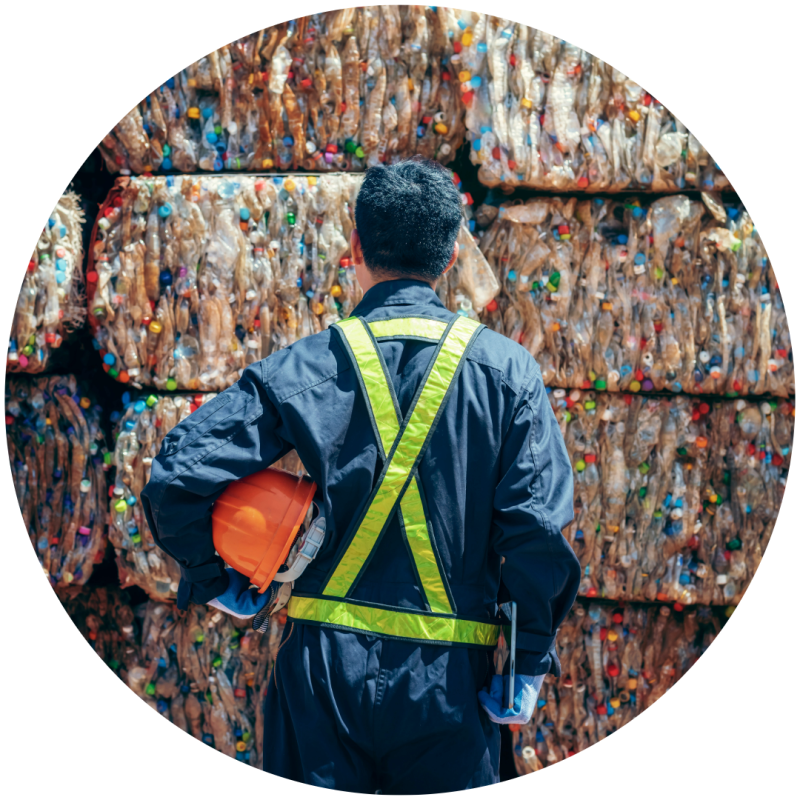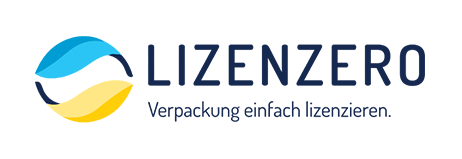The old Packaging Ordinance – objectives and implementation
Whether the former Packaging Ordinance or today's German Packaging Act, the goal remains the same: To protect resources and promote the circular economy.
How does this work (then and now)? Manufacturers and retailers who use packaging that is subject to system participation (i.e. all packaging that ends up with end consumers) pay a fee (licence fee) to a dual system. This in turn takes care of collecting, sorting and recycling the packaging. In this way, companies fulfil their extended product responsibility (because this also includes packaging) - and recycling is also taken care of! But why was the new Packaging Act needed at all? The Packaging Ordinance (in force since the 1990s) had weaknesses and open flanks in its implementation and was therefore replaced by the Packaging Act in 2019.
Fun fact: The introduction of the Packaging Ordinance also meant a major change for end consumers at the time. Since then, packaging is no longer disposed of uniformly with household waste, but separately via the recycling bin, the paper bin or paper container and the glass container. Their collection is organised by the dual systems. This keeps the packaging materials in the cycle and allows us to get the best out of them - saving enormous volumes of resources and CO₂ every day, every month and every year.


1991 to 2019: The Packaging Ordinance milestone
The Packaging Ordinance introduced in Germany in 1991 is the first to ensure that packaging waste is recycled. A real milestone! With its introduction, the so-called Dual System was also created. In addition to the disposal of conventional household waste, this was the first time that a second disposal channel was introduced specifically for packaging waste.
However, the implementation of this system still posed problems, particularly in the early years: one of the reasons for this was the monopoly position of the company ‘Der Grüne Punkt - Duales System Deutschland GmbH’ at the time. Over time, however, more and more exempt companies were added as dual systems throughout Germany. The result is a functioning overall system.
The many amendments to the Packaging Ordinance were necessary because the implementation of the requirements showed weaknesses in practice: many distributors reported no packaging at all or significantly less packaging than they actually placed on the market. As a result, large volumes of packaging ended up in the recycling bins or bags, paper and glass containers for which no one had paid a ‘licence fee’. The result: a lack of a financial basis for recycling this packaging waste. Further adjustments therefore had to be made to tighten up the regulations and introduce controls – it was time for the new German Packaging Act.


Packaging is disposed of separately at home via the recycling bin, paper waste or glass container.
The dual systems then organise the collection of the various containers and transport the packaging waste...
...to the facilities of the dual systems. Here, the packaging waste is sorted by material type and then recycled in the best possible way.

The German Packaging Act (VerpackG) replaced the Packaging Ordinance in 2019 and brought a fresh breeze: in addition to defining clear responsibilities and setting high penalties for violations, the Packaging Act also created the Central Agency Packaging Register (ZSVR). Recycling rates are also rising sharply. Incidentally, the Packaging Act was also amended in 2021.
Transparency & fair competition
With the introduction of the Central Agency Packaging Register (ZSVR) as a supervisory body, the Packaging Act creates an opportunity to review obligations for the first time. This ensures greater transparency and fair competition. Distributors must now register in the ZSVR's LUCID register (Section 9 VerpackG) and have a data reporting obligation (Section 10 VerpackG).
Higher recycling rates
Recycling rates are gradually increasing with the Packaging Act. For paper, cardboard and carton, they increased from 70% to 85% in 2019 and have been at 90% since 2022. For glass, the quotas before the Packaging Act were 75%, since 2019 they have been 80% and since 2022 they have also been 90%. The recycling rates for plastic were 36%, rose to 58% in 2019 and have been at 63% since 2022.


2019: The German Packaging Act replaces the Packaging Ordinance
Higher recycling rates
Recycling rates are gradually increasing with the Packaging Act. For paper, cardboard and carton, they increased from 70% to 85% in 2019 and have been at 90% since 2022. For glass, the quotas before the Packaging Act were 75%, since 2019 they have been 80% and since 2022 they have also been 90%. The recycling rates for plastic were 36%, rose to 58% in 2019 and have been at 63% since 2022.
2019: The German Packaging Act replaces the Packaging Ordinance
2019: The German Packaging Act replaces the Packaging Ordinance
2019: The German Packaging Act replaces the Packaging Ordinance
Take responsibility and fulfil VerpackG
Choose your packaging type:
-
Resources saved:
Resources saved
(Source: Fraunhofer UMSICHT)Here you can see how many kilograms of primary raw materials you save with your packaging licensing and its associated recycling. To clearly illustrate the volume saved, we also use a diagram containing the corresponding number of apples.
The calculated values are based on an annual study from the prestigious Fraunhofer Institute for Environmental, Safety and Energy Technology (UMSICHT).
We state the volume of primary raw materials saved and greenhouse gas emissions reduced by your company’s partnership with Interseroh on your personal resource protection certificate.
- 0 kg
- ≈ 0
Box S
Box S
Our reference box has the following specification:
Dimensions: 25,0 x 17,5 x 10,0 cm
Weight: Paper/paperboard/cardboard 65 g
Example: DHL Package S
Box S
incl. packing tape
Box S - incl. packing tape
Our reference box has the following specification:
Dimensions: 25,0 x 17,5 x 10,0 cm
Weight: Paper/paperboard/cardboard 65 g, plastic 2 g
Example: DHL Package S wrapped with PVC packing tape
Box S
incl. packing tape and paper filling material
Box S - incl. packing tape and paper filling material
Our reference box has the following specification:
Dimensions: 25,0 x 17,5 x 10,0 cm
Weight: paper/paperboard/cardboard 70 g, plastic 2 g
Example: DHL Package S wrapped with PVC packing tape + Kraft paper or wood wool
Box S
incl. packing tape and synthetic filling material
Box S - incl. packing tape and synthetic filling material
Our reference box has the following specification:
Dimensions: 25,0 x 17,5 x 10,0 cm
Weight: paper/paperboard/cardboard 65 g, plastic 12 g
Example: DHL Package S wrapped with PVC packing tape + bubble wrap with small bubbles
Air Cushion Envelope S
made of paper
Air bubble envelope S - made from paper
Our reference envelope has the following specification:
Dimensions: 180 x 265 mm
Weight: paper/paperboard/cardboard 15 g, plastic 2 g
Example: Padded paper envelope, DIN B5 format, lined inside with bubble wrap, size D4
Box M
Box M
Our reference box has the following specification:
Dimensions: 37,5 x 30,0 x 13,5 cm
Weight: paper/paperboard/cardboard 275g
Example: DHL Package M
Box M
incl. packing tape
Box M - incl. packing tape
Our reference box has the following specification:
Dimensions: 37,5 x 30,0 x 13,5 cm
Weight: paper/paperboard/cardboard 4 g
Example: DHL Package S wrapped with PVC packing tape
Box M
incl. packing tape and paper filling material
Box M - incl. packing tape and paper filling material
Our reference box has the following specification:
Dimensions: 37,5 x 30,0 x 13,5 cm
Weight: paper/paperboard/cardboard 300 g, plastic 4 g
Example: DHL Package M wrapped with PVC packing tape + kraft paper or wood wool
Box M
incl. packing tape and synthetic filling material
Box M - incl. packing tape and synthetic filling material
Our reference box has the following specification:
Dimensions: 37,5 x 30,0 x 13,5 cm
Weight: paper/paperboard/card 275 g, plastic 24 g
Example: DHL Package M wrapped with PVC packing tape+ bubble wrap with small bubbles
Air bubble envelope M
made of paper
Air bubble envelope M - made from paper
Our reference envelope has the following specification:
Dimensions: 220 x 340 mm
Weight: paper/paperboard/cardboard 22 g, plastic 3 g
Example: Padded paper envelope, DIN A4 format, lined inside with bubble wrap, size F6
Box L
Box L
Our reference box has the following specification:
Dimensions: 45,0 x 35,0 x 20,0 cm
Weight: paper/paperboard/cardboard 400 g
Example: DHL Package L
Box L
incl. packing tape
Container L - incl. packing tape
Our reference box has the following specification:
Dimensions: 45,0 x 35,0 x 20,0 cm
Weight: paper/paperboard/cardboard 400 g, plastic 6 g
Example: DHL Package L wrapped with PVC packing tape
Box L
incl. packing tape and paper filling material
Box L - incl. packing tape and paper filling material
Our reference box has the following specification:
Dimensions: 45,0 x 35,0 x 20,0 cm
Weight: paper/paperboard/cardboard 500 g, plastic 6 g
Example: DHL Package L wrapped with PVC packing tape + bubble wrap with small bubbles
Box L
incl. packing tape and synthetic filling material
Box L - incl. packing tape and synthetic filling material
Our reference box has the following specification:
Dimensions: 45,0 x 35,0 x 20,0 cm
Weight: paper/paperboard/cardboard 400 g, plastic 36 g
Example: DHL Package L wrapped with PVC packing tape + bubble wrap with small bubbles
Air Cushion Envelope L
made of paper
Air bubble envelope L - made from paper
Our reference envelope has the following specification:
Dimensions: 300 x 445 mm
Weight: paper/paperboard/cardboard 40 g, plastic 5 g
Example: Padded paper envelope, DIN A3 format, size I9
-
Resources saved:
Resources saved
(Source: Fraunhofer UMSICHT)Here you can see how many kilograms of primary raw materials you save with your packaging licensing and its associated recycling. To clearly illustrate the volume saved, we also use a diagram containing the corresponding number of apples.
The calculated values are based on an annual study from the prestigious Fraunhofer Institute for Environmental, Safety and Energy Technology (UMSICHT).
We state the volume of primary raw materials saved and greenhouse gas emissions reduced by your company’s partnership with Interseroh on your personal resource protection certificate.
- 0 kg
- ≈ 0
Shipping envelope S
without filling material
Shipping envelope S - without filling material
Our reference shipping envelope has the following specification:
Dimensions: 165 x 220 mm
Weight: plastic 10 g
Example: Plastic shipping bag for textile and courier shipping
Packaging cup S
Packaging cup S
Our reference packaging cup has the following specification:
Dimensions: Ø 15,5 cm x 6,8 cm (Capacity 500 ml)
Weight: plastic 19,4 g
Example: Salad bowls with hinged lid. Made of PET
Film S
Film S
Our reference film has the following specification:
Dimensions: 30 x 100 cm
Weight: Plastic 22 g
Example: Blown film or bubble wrap with large bubbles
Shipping envelope M
without filling material
Shipping envelope M - without filling material
Our reference shipping envelope has the following specification:
Dimensions: 245 x 320 mm
Weight: plastic 12 g
Example: Plastic shipping bag for textile and courier shipping
Packaging cup M
Packaging cup M
Our reference packaging cup has the following specification:
Dimensions: Ø 17,6 cm x 7,5 cm (Capacity 750 ml)
Weight: plastic 24,6 g
Example: Salad bowls with hinged lid. Made of PET
Film M
Film M
Our reference film has the following specification:
Dimensions: 60 x 200 cm
Weight: Plastic 45 g
Example: Blown film or bubble wrap with large bubbles
Shipping envelope L
without filling material
Shipping envelope L - without filling material
Our reference shipping envelope has the following specification:
Dimensions: 400 x 500 mm
Weight: plastic 15 g
Example: Plastic shipping bag for textile and courier shipping
Packaging cup L
Packaging cup L
Our reference packaging cup has the following specification:
Dimensions: Ø 18,9 cm x 8 cm (Capacity 1000 ml)
Weight: plastic 27,1 g
Example: Salad bowl with hinged lid. Made of PET
Film L
Film L
Our reference film has the following specification:
Dimensions: 120 x 200 cm
Weight: Plastic 90 g
Example: Blown film or bubble wrap with large bubbles
-
Resources saved:
Resources saved
(Source: Fraunhofer UMSICHT)Here you can see how many kilograms of primary raw materials you save with your packaging licensing and its associated recycling. To clearly illustrate the volume saved, we also use a diagram containing the corresponding number of apples.
The calculated values are based on an annual study from the prestigious Fraunhofer Institute for Environmental, Safety and Energy Technology (UMSICHT).
We state the volume of primary raw materials saved and greenhouse gas emissions reduced by your company’s partnership with Interseroh on your personal resource protection certificate.
- 0 kg
- ≈ 0
Bottle / jar S
with lid (plastic)
Bottle / jar S with lid – plastic
Our reference bottle/jar has the following specification:
Dimensions: Capacity 250 ml
Weight: glass 150 g, plastic 1 g
Example: Bottle with plastic lid
Bottle / jar S
with lid (aluminium)
Bottle / jar S with lid (aluminium)
Our reference bottle/jar has the following specification:
Dimensions: Capacity 250 ml
Weight: gass 150 g, aluminium 1 g
Example: Bottle with aluminium lid / cork stopper
Bottle / jar S
with lid (cork)
Bottle / jar S with lid (cork)
Our reference bottle/jar has the following specification:
Dimensions: Capacity 250 ml
Weight: glass 150 g, Other materials 1 g
Example: Bottle with cork stopper
Bottle / jar M
with lid (plastic)
Bottle / jar M with lid – plastic
Our reference bottle/jar has the following specification:
Dimensions: Capacity 750 ml
Weight: glass 500 g, plastic 1 g
Example: Bottle with plastic lid
Bottle / jar M
with lid (aluminium)
Bottle / jar M with lid (aluminium)
Our reference bottle/jar has the following specification:
Dimensions: Capacity 750 ml
Weight: glass 500 g, aluminium 1 g
Example: Bottle with aluminium lid
Bottle / jar M
with lid (cork)
Bottle / jar M with lid (cork)
Our reference bottle/jar has the following specification:
Dimensions: Capacity 750 ml
Weight: glass 500 g, other materials 1 g
Example: Bottle with cork stopper
Bottle / jar L
with lid (plastic)
Bottle / jar L with lid – plastic
Our reference bottle/jar has the following specification:
Dimensions: Capacity 1 l
Weight: glass750 g, plastic1 g
Example: Bottle with plastic lid
Bottle / jar L
with lid (aluminium)
Bottle / jar S with lid (aluminium)
Our reference bottle/jar has the following specification:
Dimensions: Capacity 1 l
Weight: glass 750 g, aluminium 1 g
Example: Bottle with aluminium lid
Bottle / jar L
with lid (cork)
Bottle/jar L with lid - Kork
Our reference bottle/jar has the following specification:
Dimensions: Capacity 1 l
Weight: Glass 750 g, Other materials 1 g
Example: Bottle with cork stopper
Paper, cardboard 0,000 kg
Plastics 0,000 kg
Glass 0,000 kg
Your license package:
Your annual licence contract includes the VerpackG-compliant licensing of the entered packaging quantities, the online seal as proof of your system participation, your annual Resources SAVED certificate and a service flat rate. To ensure that you are permanently legally compliant and do not have to worry about this every year, the contract is extended at the beginning of each year. You can cancel the contract yourself in your customer account up to 3 months before the end of each year.
25,00 € plus VAT
The German Packaging Act applies to all manufacturers and retailers who place sales packaging (including filling material) filled with goods and accumulating with the end consumer on the market. The size and type of packaging does not matter. The only thing that matters is that the packaging accumulates at private individuals' homes and is disposed of there. Licensing is based on the packaging volumes in kilograms that you put into circulation each year. Simply try out our Lizenzero calculation tool to calculate this.
The Packaging Ordinance was a German ordinance that laid down regulations for the avoidance and recycling of packaging waste. It first came into force in 1991 and was revised several times before finally being replaced by the Packaging Act, which came into force on 1 January 2019.
The main objectives of the Packaging Ordinance were:
- Avoidance of packaging waste: The regulation required packaging to be designed in such a way that it generates as little waste as possible.
- Reuse and recycling: Manufacturers and distributors were obliged to take back packaging and reuse or recycle it. This led to the introduction of collection systems such as the Green Dot.
- Product responsibility: Manufacturers and distributors were made responsible for the packaging they put on the market.
- Promotion of reusable systems: The regulation supported the use of reusable packaging to reduce waste volumes.
The Packaging Act, which replaced the Packaging Ordinance, pursues similar goals, but has made some adjustments and tightened up the regulations in order to increase recycling rates and further reduce the environmental impact.
The Packaging Act, which came into force in Germany on 1 January 2019, regulates the handling of packaging in order to minimise the environmental impact of packaging waste. It affects all parties that place packaging on the market, including manufacturers, importers and retailers.
- System participation obligation: Manufacturers and distributors who place packaging filled with goods on the market that typically accumulates as waste with private end consumers must participate in a dual system. This applies in particular to sales packaging.
- Obligation to register: Companies that place packaging on the market must register with the Central Agency Packaging Register (ZSVR). Packaging may not be placed on the market without registration.
- Data reporting: Companies are obliged to report information on the quantities of packaging placed on the market to the ZSVR.
The Packaging Act is part of efforts to reduce the environmental impact of packaging waste and strengthen the recycling industry in Germany. It obliges manufacturers to take responsibility for the entire life cycle of their packaging, including taking back and recycling packaging waste.
In the context of the Packaging Act, packaging is divided into three main categories:
- Product packaging/sales packaging: This packaging is given to end consumers together with the goods. It serves to protect the product, facilitate its handling or present it for sale. Examples include yoghurt pots, drinks bottles or toothpaste tubes.
- Shipping packaging: This packaging surrounds one or more product packages and is primarily used to enhance the presentation of the goods or to ship the goods. One example is a cardboard box that holds several tubes of toothpaste together.
- Transport packaging: This packaging facilitates the transport of goods and protects them from damage. They are typically not passed on to the end consumer, but are used by retailers or manufacturers. Examples include pallets, stretch film and transport crates.
Product packaging and shipping packaging are subject to system participation. A packaging licence must be obtained for them.
